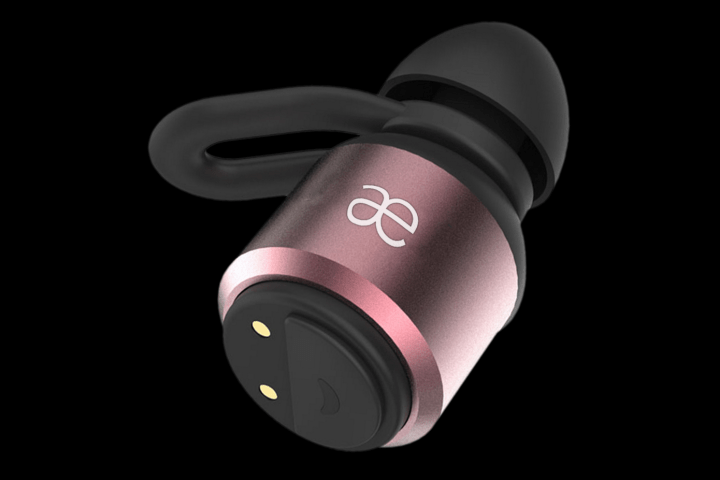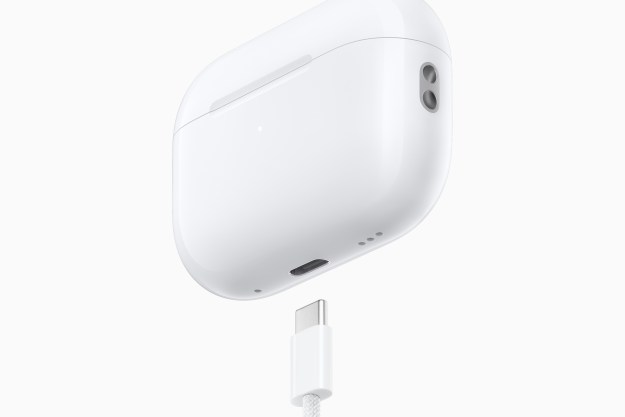
Kim reckons that Apple is bringing the fully wireless earbud category into the mainstream, and he may be right. There are already piles of them making their way to market this year, including many from crowdfunding sites like Kickstarter and Indiegogo. They may have a fighting chance, too.
The AirPods are tiny, and thanks to the lack of a tether, they’ll be easy to lose. They will also need to be stored in a charging container, which will need to be charged after every 24 hours of use, and the AirPods themselves after every five hours of use. They are not expected to sound significantly better than Apple’s regular EarPods, or at least, Apple has not made any claims that they will. And they will cost a cool $159. This adds up to a big opportunity for anyone who can provide a good alternative.
According to Kim, now is the perfect time to try to capitalize on this momentum with a competitive product that places a heavy emphasis on brand. His solution is his $89 AirPod competitor, the Aero Flux.
The Aero Flux may be half the price of Apple’s AirPods, but will potential buyers actually compare these two products?
Kim’s confidence is somewhat audacious given that he freely admits to having no experience with hardware products prior to his short-lived experiment selling used PC laptops as ready-to-run Hackintoshes. But hardware experience isn’t necessarily a requirement when you’re buying off-the-shelf components from China and reselling them under your own brand.
“It’s genuinely hard to start a hardware business from scratch,” he told Digital Trends, noting that to do so requires a lot of money he doesn’t have. Instead, he intends to follow many other companies using the so-called OEM (original equipment manufacturer) strategy, sourcing his product from other manufacturers with “the simple belief that if I sell the equal quality (perceived for genuine) for half the price, people will buy.”
The Aero Flux may be half the price of Apple’s AirPods, but will potential buyers actually compare these two products? A quick search through Amazon for “wireless earbuds” reveals at least a dozen similar products with prices that range between $25 and $199, including a $99 product called Jabees BTwins that is identical to the Flux. So identical in fact, that you can make out where Kim has tried to remove the Jabees brand from his lead product image and replace it with his own Aero logo. Kim will be one of countless entrepreneurs pitching AirPod competitors. In fact, U.K. reviewer Craig Bradshaw made the comparison when he tested the BTwins, asking if they’re “an AirPods Killer?”
The good news for Kim and his prospective Flux customers is that Bradshaw liked the Jabees earbuds, though he noted dropped Bluetooth signals and call quality were issues: “Making and receiving calls on these earbuds is almost a no go,” he wrote.

“The thing that I’m selling is the experience, the design, and the customer support,” Kim said. Customer support, as it turns out, amounts to a hassle-free returns policy. If you don’t like your Aero Flux earbuds, just send them back for a full refund. Kim’s cost on the Flux is so low, he said he might be willing to let unhappy customers keep the earbuds and not bother shipping them back, something which would just cost Kim more money. “It comes with insurance,” he said.
Actual technical support will likely be hard to come by if you buy the Aero Flux. After all, Kim isn’t a hardware guy, something that became very clear when we pressed him on the Flux’s full tech specs and whether it supports Bluetooth codecs like Qualcomm’s aptX, which promises to offer near-CD resolution wireless sound for compatible devices. “That’s the first I’ve heard of it,” he said, despite the fact that aptX is rapidly becoming standard in the wireless headphone space.
He described the Flux’s sound quality as “pretty good,” but then added a qualifier: “Sound isn’t as good as a Bose earphone,” pointing to the pair of Bose in-ear units he was using for our Skype session. “Compared to these, it lacks a lot.” What does the Aero Flux offer? Four hours of playback or talk time, which can be extended to 16 hours via the charging case’s battery, a water-resistant design, and something the pre-order page refers to as “AeroBoost,” which claims to give the Flux two times more bass boost than other earphones, though that claim is tough to qualify.
Kim is nothing if not fully transparent about his hopes for the Aero brand; the strategy is to sell as many as possible, ruthlessly competing on price if that’s what it takes to get massive amounts of sales. “I’m prepared to make just a dollar per piece to undercut everyone and get critical mass.”
Ultimately, he hopes this will give him the financial leeway to stop slapping the Aero brand on existing OEM products and start working on ODM (original design manufacturer) relationships to build products according to his own specs.

If you’re feeling skittish about dropping $89 for a product that has no reviews, from a brand that didn’t exist until a few weeks ago, Kim thinks you should consider that most of the other Chinese-made products that sell really well on Amazon started the same way.
Maybe Kim’s onto something — perhaps all it takes to sell your product is a differentiated brand around which customers can develop an affinity. Writing for Entreprenuer.com, Jim Joseph said, “We don’t fall in love with products — we fall in love with brands.” If he’s successful, Kim will join the ranks of Amazon, Monoprice, and Costco, all of whom sell products that are virtually identical to others on the market, under their own brand, often for less money. Until then, Kim said he’ll keep selling high-quality OEM products under the Aero brand. “It’s not that I want to, I have to.”
Editors' Recommendations
- AirPods 4: Everything we know about Apple’s next wireless earbuds
- Did your AirPods Pro noise cancellation just get worse?
- Apple lets AirPods Pro owners upgrade to USB-C
- New AirPods teased for 2024, to little surprise
- When it comes to charging AirPods Pro with USB-C, don’t overthink it



